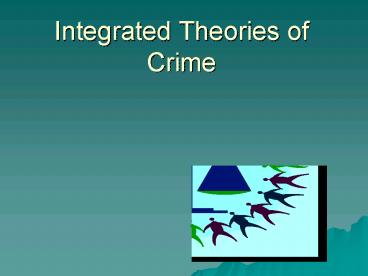Integrated Theories of Crime - PowerPoint PPT Presentation
1 / 17
Title:
Integrated Theories of Crime
Description:
Social Bonds to conventional society, which in turn promotes ... Social Capital: resources gained through quality social relationships. Sampson and Laub ... – PowerPoint PPT presentation
Number of Views:1215
Avg rating:3.0/5.0
Title: Integrated Theories of Crime
1
Integrated Theories of Crime
2
Major Factors in Development
- Limitations of Existing Theories
- Criminal Careers Approach
- Developmental Criminology
3
Integration
- Conceptual concepts from one theory overlap in
meaning with concepts from another theory. - Propositional relates propositions from
different theories. How two or more theories
make the same predictions.
4
Integrated End-to-End Model
- Social Control
- Strain
- Social Learning
Criminal Behavior
5
Nonintegrated Theories
6
Integrated Theory
- Family Social Strain
- Social Bonds
- Delinquent Peers
- Delinquency
7
Elliot, Ageton, Cantor
- Strain (in family school) weakens
- Social Bonds to conventional society, which in
turn promotes - Strong bonds to delinquent peers that are
principal factors in - The commission of delinquent behavior
8
Elliot, Huizinga, Ageton
- Strain
Weak Conventional Bonding
Strong Delinquent Bonding
Inadequate Socializaton
Social Disorganizaton
9
Pathways in the Life Course to Crime Terrie
Moffitt
- Persistent antisocial behavior is a product of
the interaction between individual traits and
social environment. - Biological deficiencies exacerbate environmental
conditions creating individuals that become
offenders.
10
Two Types of Antisocial Personalities
- Life Course Persistent
- Continuity
- Adolescent Limited Persistent
- Social Mimicry
- Maturity Gaps
- Discontinuity
11
Crime and the Life CourseRobert Sampson John
Laub
- Quality of social bonds influence social control
(especially informal controls) which explains the
onset of, persistence of, and desistance from
criminal behavior. - Social Capital resources gained through quality
social relationships.
12
Sampson and Laub
- Trajectory pathway of development
- Transitions life events
- Turning Points change in the life course
13
Sampson Laub's Development Model
ADOLESCENCE 10-17 YEARS)
CHILDHOOD (0-10 YEARS
MIDDLE ADULTHOOD (32-35 years)
YOUNG ADULTHOOD (17-32 years)
14
The Futility of Integration Thomas
Bernards Risk Factor Approach
- Characteristics of individuals that increase the
probability of engaging in criminal behavior,
regardless of the situation.
15
- Childhood problem behaviors, poor parenting,
school failures, failure to learn moral
reasoning, empathy, problem solving. - Neurotransmitter imbalances, hormone imbalances,
central nervous deficiencies, autonomic nervous
system variation. - Thinking patterns that focus on trouble,
toughness, smartness, excitement, fate,
exaggerated sense of manliness.
16
- Chronic physiological arousal and negative
emotions. - Association with others who are engaged in and
approve of criminal behavior. - Weaker attachments to other people and weaker
beliefs in the moral validity of the law. - Frequently being away from home engaging in
public activities, criminal associations.
17
Situations that have higher crime rates,
regardless of the people
- Economic modernization development-higher
property crime rates. - Economic inequality-higher rates of violence.
- Cultures which emphasize the goal of material
success - Neighborhoods with poverty, residential mobility,
family disruption. - Poverty, urban environments, racial
discrimination, social isolation-higher rates
of extreme violence. - Media dissemination of techniques
rationalizations favorable to law violation. - Societies that stigmatize deviants.































